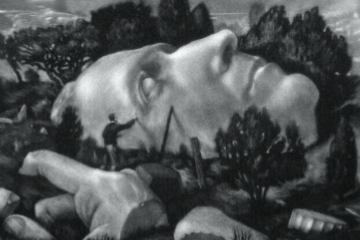Articles/Essays – Volume 50, No. 2
Reflections
In 1517, hand-pulled woodcuts, engravings and etchings were the only techniques available to quickly disseminate images and ideas to a worldwide audience. They were the internet of their day. But in case you haven’t noticed, a lot has changed in 500 years.
We take it for granted that we can now make (or take) images and scatter them across the world in a fraction of a second. If for some strange reason we want put text or an image on paper rather than on a screen, it’s just as easy. Just click “print” and the paper slides out of the box, the words or images magically attached. All effort has evaporated. Surely our age must be the culmination of a movement that started over 500 years ago when the internet was very slow and was made up of woodcuts, metal type, engravings, couriers and horses.
And yet . . . while things have undoubtedly gotten easier, have they gotten quantitatively better? I recently had the pleasure of examining a pristine impression of Albrecht Dürer’s engraving Adam and Eve, made in 1504. It depicts the first couple in ideal proportions and is so skillfully engraved with a million tiny flicks of the burin that you can almost feel the divine breath heaving under Adam’s muscular chest. It looks as if it could have been made yesterday. It is an astounding print, unequalled in the intervening 513 years. No sophisticated digital process can reproduce the effect of seeing this engraving in person.
While I don’t claim to be another Dürer, I do use exactly the same process that he used. I don’t do this just to prove that I can do it or to revive an obsolete technology just to show how obsolete it is. (Few of us would trade in a mountain bike for a velocipede!) I use Dürer’s technique because it is still the most versatile, luscious and expressive linear printmaking technique that we have. In short, though we have many newer techniques, we don’t have any better techniques.
Look at any contemporary process—ink jet, offset lithograph, an ultra-high resolution smartphone screen, anything—with a magnifying glass. All modern processes are made up of broken points of some kind. When you look closely, every single digital image becomes a flat ghost of a grid, a sophisticated but disjointed and lifeless mosaic.
Now look at a genuine engraving with a magnifying glass. I think you will be struck by the sheer physicality of the image. Lines don’t dissolve into broken dots! They remain lines no matter how many times you magnify the image. The paper itself bears witness to the immense pressure needed to print an engraving in the embossed edge on all four sides. The lines in an engraving range from thin, spidery lines the thickness of a human hair to thick worms of ink rising above the paper. The slightest change in pressure of the engraver’s hand corresponds to variations of width and thickness of every printed line. The ink isn’t flat, but sculptural, alive, much more so than even a pen and ink drawing.
For me, turning off all digital devices and using the tools of the sixteenth- and seventeenth-century internet lets me make tangible analog multiples that can be spread all over the world, but retain the intimate sculptural physicality that is so lacking our image-saturated world.


 Back to full Issue
Back to full Issue

